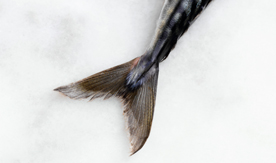
Studies Lead to Improved Fish Advisory for Pregnant Women
Editor’s note: This version has been updated
Two studies by researchers at the University of Maine’s Sustainability Solutions Initiative (SSI) uncovered compelling data on women’s knowledge of both the dangers and health benefits of eating fish while pregnant. The first study found that Maine Center for Disease Control and Prevention’s (MeCDC) advisory led women to decrease their consumption of fish, while a follow-up study found a newly-designed advisory led to a healthier, more balanced approach to fish consumption.
Mario Teisl, professor in the School of Economics, will present and discuss results of the studies, which were published in two peer-reviewed journals, as a featured speaker at the U.S. Environmental Protection Agency’s (EPA) 2014 National Forum on Contaminants in Fish. Both journal papers are among the first to examine how information about methylmercury in fish is conveyed to pregnant women in specific states and how that information is used, which is information the EPA has indicated it needs.
Teisl has been part of two research teams from SSI’s Knowledge to Action Collaborative that have closely examined MeCDC’s methylmercury advisories sent to pregnant women. He will lay out how the successive sets of data tracked an evolution in the way information is conveyed to and interpreted by pregnant women in Maine.
“MeCDC suspected that the original advisory was not working as best as it could for this audience and our initial study confirmed the state could do better,” Teisl said.
In the first study, published in 2011 in the journal Science of the Total Environment, Teisl and colleagues found that the advisory was changing pregnant women’s eating habits, but not always in the intended manner. Instead of limiting high-mercury fish and switching to a careful diet of low-mercury fish, many pregnant women were dramatically decreasing their overall consumption of all fish, thus missing many of the benefits of eating fish. The misinformation seemed to stem from the fact that the advisory was aimed at sports fishermen and mainly focused on the risks of eating sport-caught fish.
“The old pamphlet was targeted more toward anglers. On the cover, there was a photo of a family fishing. The problem is that very few women eat sport-caught fish. Most eat fish from the grocery store. A lot of pregnant women didn’t understand how the information pertained to them,” Teisl said.
In 2006, the MeCDC redesigned its advisory, adding specific information about fresh, frozen and canned fish. Sue Stableford, a health literacy expert at the University of New England, worked closely with the MeCDC on both advisories, providing extensive assistance with research, focus group testing, and use of ‘easy-to-read’ techniques.
The new literature contains recipes, meal plans and colorful charts, informing women of fish to avoid, fish to limit and fish that are low enough in mercury to eat twice a week while pregnant. The pamphlet emphasizes the importance of fish in the diet, including the fetal/maternal health benefits of Omega 3 fatty acids and protein. In the second study, published in 2013 in the journal Environmental Science, Teisl and colleagues found women who read the updated advisory were knowledgeable about healthy fish consumption in pregnancy. People who did not read the advisory generally lacked essential knowledge about healthy fish diets.
“Our evaluation of the Maine CDC’s updated fish consumption advisory suggests that it successfully improved women’s specific knowledge of both the benefits and risks of consuming fish while pregnant. This improved knowledge has the potential to minimize methylmercury health impacts and maintain, if not increase, overall low-mercury fish consumption,” said Haley Engelberth, who received a master’s of science in Ecology and Environmental Science from UMaine in 2012. Engelberth was on both SSI methylmercury research teams and the lead author of the 2013 paper.
Other researchers on the teams included: Kathleen P. Bell, associate professor, UMaine’s School of Economics; Eric Frohmberg, (then) toxicologist, state of Maine; Karyn Butts, research associate, University of Southern Maine; Sue Stableford, director of the Health Literacy Institute at University of New England; Andrew E. Smith, director, Environmental and Occupational Health Programs, Maine CDC; Kevin J. Boyle, (then) professor of ecology and environmental sciences, UMaine.
Teisl will make his presentation at the Sept. 22–24 conference in Alexandria, Virginia.
Funding for this research was provided by National Science Foundation award EPS-0904155 to Maine EPSCoR at the University of Maine and by the Maine Center for Disease Control & Prevention through the U.S. Center for Disease Control and Prevention National Public Health Tracking Grant and U.S. EPA Cooperative Agreement #CR82628301-0.
Contact: Margaret Nagle, 207.581.3745
